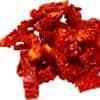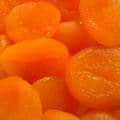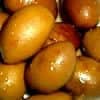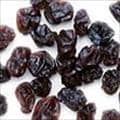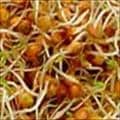Okay, so let’s first look at what our government recommends we eat, better known as the USDA Food Guide Pyramid (or what’s now called MyPyramid).
According to mypyramid.gov, a healthy diet is one that:
- Emphasizes fruits, vegetables, whole grains, and fat-free or low-fat milk and milk products;
- Includes lean meats, poultry, fish, beans, eggs, and nuts; and
- Is low in saturated fats, trans fats, cholesterol, salt (sodium), and added sugars. (source: http://www.mypyramid.gov/guidelines/index.html)
I’m all for fruits and vegetables, lean meats, poultry, eggs and nuts. I’m not even saying that everything in that short list of recommendations is wrong. However, if you look at the LARGEST section of the Pyramid, which now that they’ve turned the slices sideways is a bit tougher to discern, it’s asking us to get the
most servings per day of a food group that’s not only largely subsidized in this country, but one that requires THE MOST PROCESSING TO MAKE IT EDIBLE. We’ll talk more about the notion that “whole grains are healthy” in another post, but for now let’s just keep it to the basics of
whole foods versus processed foods. The USDA even recommends that we eat fat-free or low-fat milk and milk products. Really? Come on, are they trying to tell us that milk that comes straight from the cow isn’t recommended but milk that’s been processed and something has been removed from it is actually healthier? Is the government smarter than mother nature?! Just THINK about it.
Upon a bit more digging, I discovered that the USDA’s Dietary Goals report that comes along with the Pyramid goes on to recommend:
“that Americans:
- Increase consumption of fruits, vegetables, and whole grains;
- Decrease consumption of:
- refined and processed sugars and foods high in such sugars;
- foods high in total fat and animal fat, and partially replace saturated fats with polyunsaturated fats;
- eggs, butterfat, and other high-cholesterol foods;
- salt and foods high in salt; and
- Choose low-fat and non-fat dairy products instead of high-fat dairy products (except for young children).” (Source: History of the Dietary Guidelines: page E4-1 – PDF)
Wait, didn’t they just tell us to include eggs in our diet, but then they went on to tell us to reduce our consumption of them? What gives? Clearly they’re confused.
Furthermore, it should be noted that the Dietary Goals for the United States (aka: The McGovern Report) have been around since 1977. Has anyone noticed that this country has gotten a bit fatter, sicker and that people are being diagnosed with autoimmune conditions earlier and more often than ever before? Hasn’t it become a bit of commonplace knowledge that the current generation of children will be the first to NOT live longer than their parents did? I guess the government is going to need to step aside and let those of us who actually care about the health of other people do some of the educating and guiding about WHAT TO EAT. If you’re unclear as to how the government even comes to a decision on what to tell us to eat, Marion Nestle’s book
“Food Politics” is an interesting resource to peruse. While I’m not a huge fan of the foods that Nestle tends to recommend that people eat, she’s certainly a leading authority in the US on the inner workings of how politics affect what’s on your plate every day.
 |
Nestle’s exposure of
the political landscape
of food in the US is
worth reading. |
With regard to changes that have been made to the
Dietary Guidelines, Nestle states that
“In an effort to achieve consensus on these innovations, the USDA invited leading nutrition authorities in government, research, the food industry, and agricultural commodity groups to review preliminary drafts because it ‘felt that the food industry groups would have a vital interest in any food guide sponsored by the government.’ Indeed they did.” (Nestle, 36) Well OF COURSE the food industry and agricultural commodity groups will be interested! It’s their bottom line, well, on the line if the government starts telling people to eat LESS of anything that they produce.
Inevitably, changes are made over the years, and as the food guide has shifted and changed, and some food groups were recommended to be eaten in lower quantities, Nestle states that
“the AMA (American Medical Association) noted that ‘the recommendations carry with them the underlying potential for…discouraging the agricultural production of certain food products which may not in the view of the government be supportive of the dietary goals.’” Nestle goes on to say that “although opposition to the Dietary Goals often was expressed as skepticism about the quality of the underlying science, it derived more directly from the profound economic implications of the advice. (Nestle, 41)
 |
Are you confused, too? Maybe because it actually
DOESN’T make sense to eat this way for your health! |
Did you read that? Opposition to the pyramid that was developed was NOT mostly based on science that may or may not have supported it, it was based on the economic implications of the advice! I’m sorry folks, but I don’t see any nutritionist making money off of telling you to eat more of the foods in the diagram I’m recommending you follow. In fact, the more closely you follow my guide, the less help you’ll need from a nutritionist! On the contrary, the more you follow the USDA’s recommendations, the more processed foods you have to buy to keep up with what they want you to eat. You can’t possibly get in all those servings of grains and low-fat dairy without your breakfast cereal or your sugar-free yogurt for a snack, can you? Those foods are highly processed and large corporations are making loads of money when you buy them. Oh, and they’re made with pretty much the lowest common denominator when it comes to ingredients: corn,
wheat and soy. Yes, even that innocent looking
Yoplait Light Yogurt with the alluring ads describing the fantastically indulgent flavors (I should know, I used to down these puppies like crazy) include high fructose corn syrup in their ingredients. Ick.
Okay, so after all this discussion about why the USDA Food Guide Pyramid is not based on helping you to understand which foods will promote health, you’re probably wondering what the heck you ARE supposed to eat.
To explain my REAL FOOD PYRAMID in words:
 |
| Click to view larger & print. |
Lean meats, eggs and fish/seafood are ideal sources of protein for human health. By lean meats I am talking ideally about grass-fed, pastured, wild forms that contain far less fat than commercially raised options and the fat that they DO contain has a healthy profile high in Omega 3s. If you’re going to consume commercially raised meats, opt for the leanest cuts possible to avoid the unhealthy fats that result from grain-feeding and stressful living conditions of the animals.
Vegetables and fruits are an ideal source of nutrient-dense carbohydrates and are easily digested by most people. There is no reason to consume grains or legumes in an effort to get carbohydrates or fiber into your diet. I promise you, you will get plenty of carbs and fiber from what mother nature allows you to pick from the face of the earth without further processing. From the ground to your mouth, it’s that simple. (Okay, maybe give it a rinse first if it’s got some dirt on it!)
Naturally occurring fats and oils are healthy. Period. We needn’t avoid those fats which can be found in nature including that which is associated with well-raised meat, avocados, coconut, etc. Processed fats and oils are all to be avoided (canola, corn, soybean and “vegetable” oil). See my post on
“Fats: Which to Eat and Which to Ditch” for more on that.
Sugar has no place in my model. If you’re going to eat it, refer to my post
“The Dish on Sugar and Sweeteners” to figure out which are the lesser of the evils. Artificial sweeteners are not food.
